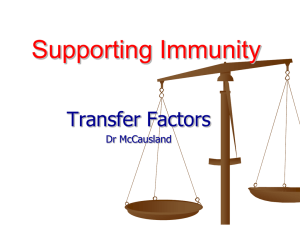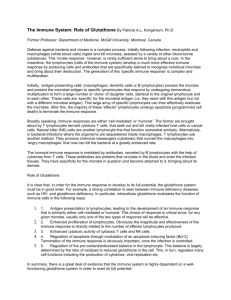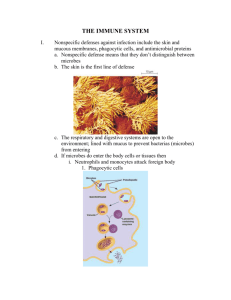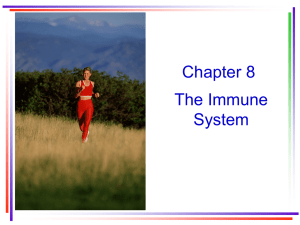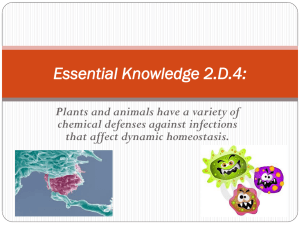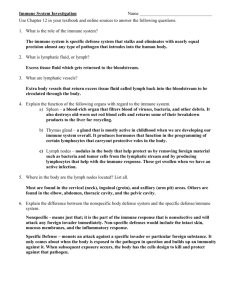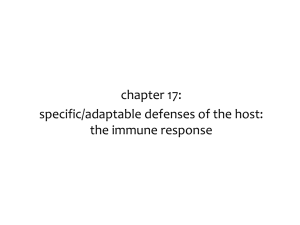Chapter 43 Power Point notes
advertisement
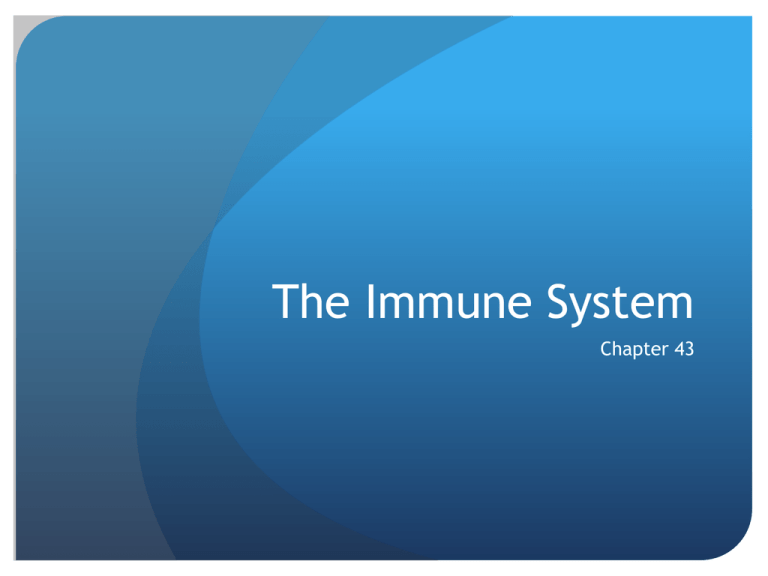
The Immune System Chapter 43 Overview Innate vs. Acquired Immunity Innate Immunity: Present from the time of birth Nonspecific External barriers, Mucous membranes, macrophages Acquired Immunity: Highly specific Humoral response (antibodies) Cell-mediated response (cytotoxic lymphocytes) Innate vs. Acquired Immunity 43 ~1 Innate Immunity External Defenses: Skin Acidic pH Physical barrier Mucous membranes Traps microbes Antimicobial Proteins - Lysozyme Enzyme that destroys bacteria Internal Cellular & Chemical Defenses Phagocytosis The ingestion of invading microorganisms by certain types of white blood cells 4 white blood cells are phagocytic Neutrophils Macrophages Eosinophils Dendritic cells Phagocytosis Lymphatic system Internal Cellular & Chemical Defenses Antimicrobial Proteins Attack microbes Lysozyme Complement system – 30 proteins that activate when microbes invade Interferon – protection against viral infection by limiting cell to cell reproduction Internal Cellular & Chemical Defenses Inflammatory Response – damage to tissue by physical injury Histamine causes increased blood flow to the inured site (redness & heat = inflammation) Help deliver antimicrobial proteins and clotting elements to the injured site Inflammatory Response Internal Cellular & Chemical Defenses Natural Killer Cells Patrol the body and attack virus-infected body cells and cancer cells Apoptosis – NK cells release chemicals that lead to death of the cell by apoptosis (programmed cell death) 43 ~ 2 Acquired Immunity Activates Lymphocytes Antigen – any foreign molecule that is specifically recognized by lymphocytes and elicits a response from them 2 main types of lymphocytes B lymphocytes (B cells) T lymphocytes (T cells) Both circulate through the blood and lymph and are concentrated in the spleen, lymph nodes, and other lymphoid tissue Lymphocyte development Originate from pluripotent stem cells in the bone marrow T cells develop in the Thymus B cells remain in bone marrow and complete maturation there Lymphocyte development Primary vs. Secondary Immune response Primary immune response: occurs the first time the body is exposed to a particular antigen Peaks about 10-17 days after exposure Secondary Immune response: occurs after a second exposure to the same antigen Faster Greater magnitude More prolonged Primary vs. Secondary Immune response 43.3 ~ Humoral & Cell-mediated response Humoral immune response – involves the activation and clonal selection of B cells, resulting in production of secreted antibodies that circulate in the blood and lymph Cell-mediated immune response – involves the activation and clonal selection of cytotoxic T cells which directly destroy certain target cells. Humoral vs. cell-mediated immune response 43.4 ~ Distinguishing self from non-self Blood groups and transfusions Tissue and organ transplants Blood groups & Transfusions A, B, AB, and O blood groups A red blood cells have A antigens on their surface and make antibodies against the B antigen. Transfusion reaction – chills, fever, shock and kidney malfunction AB = universal recipient O = universal donor Rh negative mother carries a fetus that is Rh positive mother mounts a humoral response. Danger occurs in subsequent pregnancies with Rh positive fetus. Tissue & Organ Transplants A rejection reaction is mounted in most graft and transplant recipients because molecules are foreign. No danger of rejection if the donor and recipient are identical twins or if tissue is grafted from another part of the same person’s body. 43.5 ~ Immune system Diseases Allergies – are exaggerated (hypersensitive) responses to certain antigens called allergens Typical allergy symptoms: sneezing, runny nose, tearing eyes, and smooth muscle contractions Anaphylactic shock – acute allergic response leads to a whole-body life-threatening reactions. Responses to bee venom, penicillin, peanuts, fish Epinephrine (epipen) counteracts this allergic response Autoimmune Diseases: The immune system loses tolerance for self and turns against certain molecules Lupus – skin rashes, fever, arthritis, and kidney dysfunction Rheumatoid arthritis – painful inflammation of cartilage and bond of joints Multiple Sclerosis – T cells enter CS and destroy myeline sheath Arise from some failure in immune system regulation Immunodeficiency Diseases: The inability of the immune system to protect the body from pathogens or cancer cells that it should normally Inborn (SCID) vs. acquired (AIDS) Stress & the Immune System: Healthy immune function depends on both the endocrine system and nervous system Hormones secreted by the adrenal glands during stress affect the # of white blood cells and can suppress the immune system Acquired Immunodeficiency Syndrome (AIDS): Highly susceptible to infections (Pneumonia, bronchitis) Loss of helper T cells both humoral and cell-mediated are imparied Results from infection by HIV (retrovirus)
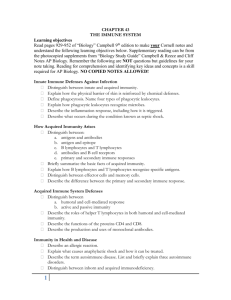
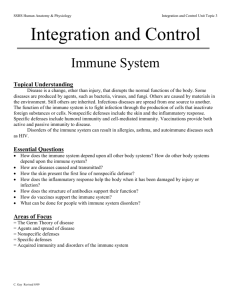
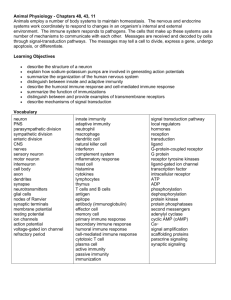
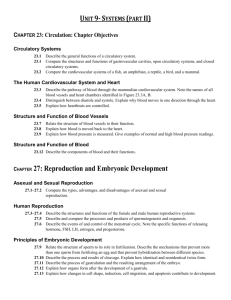



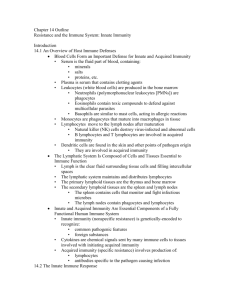

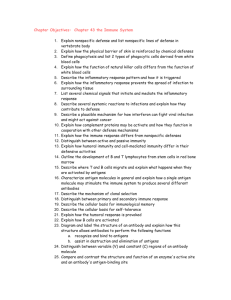


![Immune Sys Quiz[1] - kyoussef-mci](http://s3.studylib.net/store/data/006621981_1-02033c62cab9330a6e1312a8f53a74c4-300x300.png)
